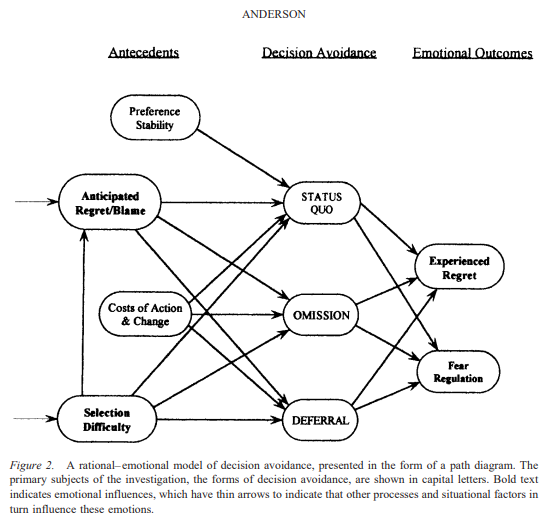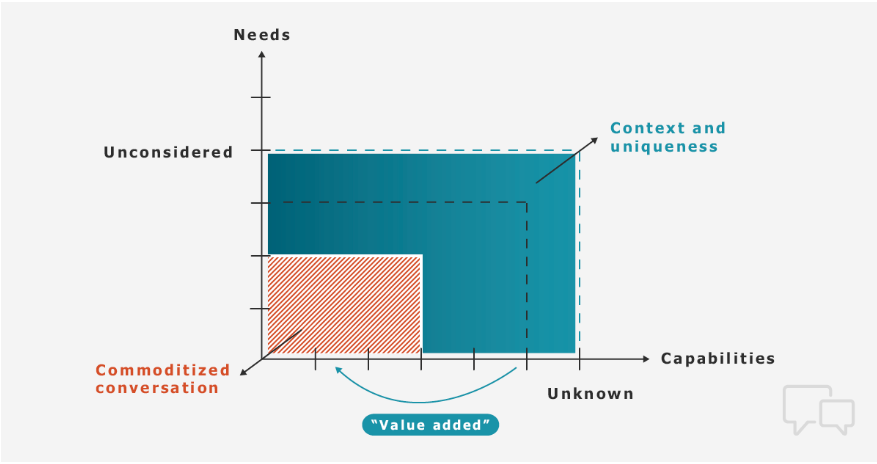“The experience of postponing and avoiding certain choices is universal, yet often appears to work against individuals’ goals. Delays transform into lost opportunities, and adhering to the status quo is frequently unjustified given advantageous alternatives.”
- Christopher J. Anderson, The Psychology of Doing Nothing: Forms of Decision Avoidance Result From Reason and Emotion
Defining status quo bias
When faced with change and big decisions, we often opt to do nothing because sticking with what we’re used to feels safer in the moment— but it almost always costs us more down the road.
In psychology, this is called status quo bias and presents as “a decision maker’s inflated preference for the current state of affairs” (source). We see this all the time in business, especially in B2B where decision makers are responsible for enacting change at the organizational level.

The status quo bias in sales and marketing has been covered extensively by Corporate Visions. Tim Riesterer, Chief Strategy Officer of Corporate Visions, also offers a solution to status quo bias — introducing “unconsidered needs” and “escaping the commodity box” — two ideas we’ll explore in this article in relation to sales enablement.
To get an expert perspective on status quo bias in sales enablement, I spoke to Founder & Chief Enablement Officer of The Enablement Group, Marc McNamara. He shared his experience with problems stemming from status quo bias in sales enablement, what the unconsidered needs of sales enablement are, and what sellers and buyers can do to overcome bias in order to see real improvement in their organizations.
The costs of status quo and unconsidered needs of sales enablement
“What are Unconsidered Needs?" asks Riesterer. "Unconsidered Needs are challenges, shortcomings, or missed opportunities that your prospect doesn’t yet know about but are holding them back from their most important business goals. They are, by definition, previously unconsidered. So you won’t be able to identify Unconsidered Needs through voice of the customer research.”
The status quo that sales enablement solutions replace often consists of outdated legacy processes and tools, bloated and stale document management systems, and poor communication and data tracking.
Put succinctly, the main unconsidered need in sales enablement is stemming the flow of losses caused by status quo.
The following are some of the main problems McNamara says companies haven’t considered when choosing status quo over a sales enablement solution.
Seller churn when expressing product value is too difficult
“Salespeople are funny,” said McNamara. “They want to work for companies where the products are easy to sell and when they don’t easily find success, they leave. This is not necessarily the fault of the solution or product. You can have just an OK product, and still beat the competition because you are really good at enabling your sellers to sell. It comes down to how to effectively teach and coach your team to engage and demonstrate how you solve the customers’ problem and achieve their objectives.”
Basically, if companies don’t make it easy for sales reps to not only understand the value of the product themselves but be able to express it to customers, good sales people leave and find it difficult to attract new talent. “A feeling of staleness and lack of excitement makes them quit. If selling is too hard because they are not adequately supported, they will quit. if they aren’t effectively made aware and coached on important new information they will quit,” said McNamara.
And backfilling churn is a huge challenge.
“Recruiting is really hard and expensive. The best thing to do, like any marketing effort, is hold on to the people you have and enable them to better achieve the objectives you have for them," said McNamara.
By not having a comprehensive readiness program in place you're wasting a lot of capital. Now, that's not to say you won't find some people who will do really good work for you, but that will become rarer as time goes on. We know that the best path to success is to provide a modern enablement program that not only accelerates experience but continuously helps improve performance across the entire team, from BDRs to Managers and all Sales Executives.
Loss of productivity in sales
When sales teams don’t have the tools they need to be productive, the loss is “huge,” says McNamara. And if you have a large sales force, the loss is exponential. If reps feel they can’t be productive or are wasting their time, they leave.
Loss in subject matter experts’ wasted time
Many companies are operating on a status quo that McNamara calls “the big hot mess.”
The big hot mess occurs when subject matter experts spend their time creating content that never gets used or shared, so they simply continue to present information live, over and over, eating up valuable time. Then, all their knowledge and the assets they created pile up into a disorganized and stale content graveyard or they struggle to get to the important work they should be doing.
“If you took every piece of content and you multiplied the time it took each SME to make those presentations, how much money was that? Millions, gone up in smoke," said McNamara. "And often it was wasted from the start because of a lack of planning, resulting in the ROI of those assets being extremely low. There are a lot of reasons this happens, but often the situation is not improved because rather than examine the best methods and processes, people just continue to do the same things they were doing, ultimately exacerbating the problem(s).”
Throwing wasted money into old, ineffective systems like a traditional LMS
Another common problem in the cost center is old learning management systems that are ineffective and underused.
Speaking on his direct experience helping one particular company implement sales enablement, McNamara said, “They had an LMS which was costing them more money per month than if they just bought a new LMS. They were spending a huge amount of capital on maintaining a broken system of content and processes to keep the current LMS available. The solution in the end was actually not to have an LMS at all.”
Being a “late adopter” and playing catch up
Another unconsidered need is playing catch up when the dreaded time arrives to actually deal with a problem after it is too late. When the status quo becomes a big problem because change has been put off for so long.
“Many companies wake up suddenly and try to make quick changes to catch up to everyone else who had put solutions like sales enablement in place years before,” according to McNamara. “We find in many cases though, by not considering all the impacts these changes will have, they make it worse, ultimately costing them time and missed opportunities with customers.”
NBA Coaching Legend Alvin Gentry had similar advice in his recent interview with Bigtincan CMO Rusty Bishop. He advises dealing with problems early while they are still manageable, saying, “I think the one mistake that a lot of leaders make is that they leave little problems alone until they develop into big ones. It’s much easier to deal with a small problem and eliminate it — don’t wait until it’s this gigantic problem and now it’s really tough to eliminate.”
How to overcome status quo bias in sales enablement buying decisions
So how can buyers and sellers get past status quo bias to overcome it?
You need to focus on the unconsidered needs and costs of the status quo, rather than checking boxes off a customer-built list of requirements for a new sales enablement solution. If you take the latter approach, the decision-making process becomes even more difficult because every solution looks the same and pushes the decision maker back toward the perceived safety of the status quo.
Riesterer calls this conundrum the “commodity box.”
According to Riesterer, “When you create your value proposition based on your customer’s stated needs, you end up delivering commodity messages that won’t differentiate you. Why? Because all of your competitors are relying on the same inputs from their prospects and customers. And you’ll be responding with similar capabilities to meet those identified needs.”

To make the best decision, both buyers and sellers need to think outside the commodity box.
Don’t let fear or anticipation of regret stop you — because those consequences show up tenfold when you avoid change, anyway. There are actions you can take to defeat status quo bias (and the resulting costs detailed here) from stalling your decision to take the next step.
Here’s what to do if you’re considering sales enablement as a buyer:
- Assess your situation - calculate the costs of what you are already doing.
- Prepare to make changes - lay the groundwork for success to reduce anticipation of or cause for regret.
- Realize you won’t be doing it alone - there are experts who can help.
- Be forward-thinking— let long-term, exponential benefits drive your behavior as opposed to inertia that ends up costing in the long run.
If you’re a seller — listening to the customer is of course essential, but instead of just giving responses to their list of questions, you need to ask more questions to get to the bottom of the customer’s real problem in order to offer solutions. Don’t be afraid to bring your expertise into the conversation and enlighten the customer about problems they haven’t even realized yet.
Everyone loses when short-term thinking and inaction prevail. That’s always true in business and in life.
Ready to shake up your status quo but not sure how to start? Speak to experts who can guide you through the process.
